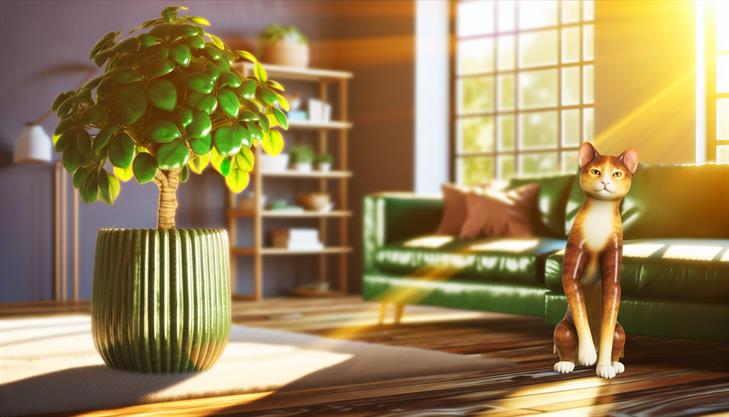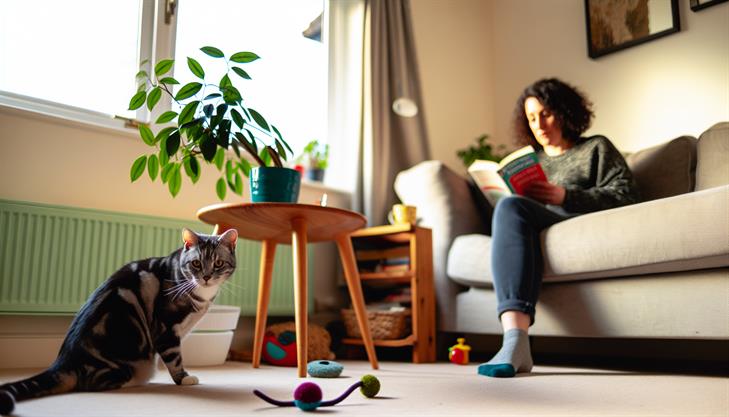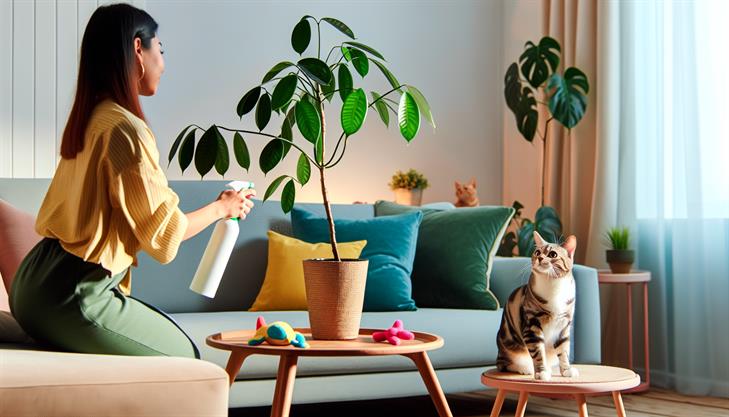If you’re a cat owner with an affinity for indoor plants, you may have found yourself playing a delicate balancing act between your leafy companions and your furry friends. Among the popular choices for indoor greenery, the Money Tree, with its braided trunk and lush, vibrant leaves, often takes center stage. But an essential question looms for every cat-loving plant enthusiast: are Money Trees toxic to cats? With our feline companions’ penchant for nibbling on leaves every now and then, understanding the safety of your household flora is paramount. Delving into the facts not only ensures the well-being of your curious kitty but also brings peace of mind as you cultivate your indoor garden. This guide will unravel the mystery surrounding the Money Tree and its potential effects on cats. Stay with us as we explore the plant’s safety profile and offer practical tips to harmonize your love for greenery with your responsibility as a pet parent.
Understanding Money Trees: A Quick Overview
Money trees, scientifically known as Pachira aquatica, are popular houseplants cherished for their attractive appearance and easy-care nature. While they are appreciated for their lush green leaves and braided trunk, one common concern among pet owners is whether money trees are toxic to cats.
The good news for cat owners is that money trees are not toxic to cats. This means that if your curious feline decides to nibble on a leaf or two, it’s unlikely to cause any severe toxic reaction. However, it’s important to exercise caution as ingestion of any plant material can lead to minor gastrointestinal upset in cats. Symptoms may include nausea, vomiting, or diarrhea, although these are generally mild and resolve quickly.
Despite their non-toxic status, it’s always a good idea to take preventative measures to ensure your pets don’t develop a habit of munching on houseplants. Here are some step-by-step tips to keep your money tree and cat safe and happy:
-
Placement: Position your money tree in a location that’s less accessible to cats. High shelves, hanging baskets, or areas where your cat does not typically roam are ideal.
-
Cat Deterrents: Use natural deterrents to discourage your cat from approaching the plant. Citrus peels or a light dusting of cayenne pepper on the soil can be effective as most cats find these smells unpleasant.
-
Provide Alternatives: Often, cats chew on plants out of curiosity or boredom. Offering safe cat grasses or catnip can provide a satisfactory alternative and distract them from other plants.
-
Cat Training: Reinforce commands like "no" or "leave it" when your cat approaches the plant. With time and positive reinforcement, cats can learn which areas or items are off-limits.
-
Observation: Always monitor your cat’s behavior around plants. If you notice repeated attempts to sample the money tree, it may be best to place it in a room where your cat cannot access it.
Although money trees are safe for cats, it’s crucial to be informed about other common household plants that may pose a risk. Plants like lilies, philodendrons, and pothos are known to be toxic and should be kept out of reach or avoided altogether if you have cats in your home.
By understanding these basics and taking appropriate measures, you can ensure that your home remains a safe haven for both your money tree and your beloved feline companion. With thoughtful placement and a bit of training, it’s possible to enjoy the presence of these beautiful plants without compromising your pet’s health.
Identifying Symptoms of Toxicity in Cats
Money trees, also known as Pachira aquatica, are popular houseplants cherished for their braided trunks and lush green foliage. As a cat owner, you might be wondering: are money trees toxic to cats? This is a valid concern, as many household plants can pose serious risks to feline health.
Are Money Trees Safe for Cats?
Fortunately, money trees are generally considered non-toxic to cats. Unlike certain plants like lilies or sago palms, which are highly poisonous, money trees do not contain harmful substances that are likely to cause serious illness in your feline companions. However, it’s still important to monitor your cat’s interaction with the plant to ensure they don’t experience any adverse effects from ingestion.
Recognizing Symptoms of Plant Toxicity in Cats
Even though money trees are non-toxic, cats can still experience mild irritation or digestive upset if they chew on the leaves in excess. It’s crucial to know how to identify symptoms of plant toxicity, which may include:
-
Drooling or Foaming at the Mouth: A sign that your cat has ingested something irritating.
-
Vomiting or Diarrhea: Common indicators that something is disrupting your cat’s digestive system.
-
Lethargy: A noticeable decrease in energy can indicate your cat isn’t feeling well.
-
Difficulty Breathing or Swallowing: These are more severe symptoms that require immediate veterinary attention.
If you observe any of these symptoms in your cat, the best course of action is to contact your veterinarian for guidance.
Preventative Measures
While money trees are not toxic to cats, it’s still a good idea to take preventative steps to minimize any potential risks:
-
Place Plants Out of Reach: Keep your money tree on a high shelf or use hanging planters to prevent easy access.
-
Use Deterrents: Cats are often deterred by citrus scents. Spraying a diluted citrus solution near the plant can discourage nibbling.
-
Provide Alternatives: Ensure your cat has plenty of toys and safe plants, like cat grass, to satisfy their play or dietary needs.
-
Environmental Enrichment: A stimulating environment can reduce curiosity-driven nibbling. Regular playtime and interaction can keep your cat engaged and uninterested in the plant.
Steps to Take if Your Cat Ingests a Plant
Should your cat chew on the money tree and show mild signs of distress, take these steps:
-
Remove Access: Move the plant to a location your cat cannot reach.
-
Clean the Cat’s Mouth: Gently rinse your cat’s mouth with water to remove any plant material.
-
Monitor for Symptoms: Watch your cat closely over the next 24-48 hours to see if symptoms develop or if they worsen.
-
Consult a Veterinarian: If you notice any persistent or severe symptoms, seek veterinary care promptly.
Conclusion
In summary, money trees are a beautiful and safe option for homes with cats, given their non-toxic nature. By understanding and identifying potential symptoms of plant toxicity, utilizing preventative measures, and knowing how to respond if your cat does ingest some leaves, you can create a harmonious environment for both your feline friends and your indoor greenery. This proactive approach ensures your cat can live safely alongside your cherished money tree.
Safe Alternatives to Money Trees for Your Home
Money trees, known scientifically as Pachira aquatica, are popular houseplants appreciated for their ability to thrive indoors and their symbolic significance of bringing wealth and prosperity. However, if you’re a cat owner concerned about your furry friend’s safety, it is essential to understand whether these plants pose any toxicity risks.
Are Money Trees Toxic to Cats?
Good news for cat enthusiasts: money trees are not toxic to cats. According to the ASPCA (American Society for the Prevention of Cruelty to Animals), Pachira aquatica is non-toxic to cats, dogs, and horses. This means that if your cat happens to nibble on a money tree leaf, you don’t have to worry about any severe toxic reactions.
Common Issues and Concerns
While money trees are non-toxic, it’s important to keep in mind some potential issues that could arise if your cat interacts with the plant too frequently:
-
Digestive Upset: While not toxic, eating any plant material can lead to mild gastrointestinal issues in cats, such as vomiting or diarrhea. If you notice any unusual symptoms in your cat after it chews on the plant, it might have a sensitive stomach reacting to the fibrous leaf matter, not due to toxicity.
-
Plant Damage: Cats are naturally curious and may enjoy batting at the leaves or climbing the stems, which could damage your plant. If your money tree shows signs of stress from cat interactions, consider protective measures.
Setup Tips for Pet Owners
To ensure both your plant and cat remain happy, here are some setup tips to consider:
-
Strategic Placement: Position your money tree in an area that is less accessible to your cat. High shelves, tables, or in hanging baskets are ideal spots that keep the plant out of reach but still thriving in suitable lighting.
-
Engage Your Cat: Provide distractions such as cat grass or designated cat-friendly plants like spider plants or catnip to keep your feline’s attention away from your money tree. This can also help satisfy their nibbling or chewing instincts without posing any risks.
-
Repellent Sprays: Consider using a pet-safe repellent spray on your money tree. Such sprays often deter cats from chewing or approaching the plant, ensuring protection for both parties.
Additional Advice
- Monitor: Keep an eye on your cat for any unusual behavior following interactions with your money tree. Although the risk is low, ensuring your pet’s safety is paramount.
- Training: Positive reinforcement can be effective in training your cat to stay away from certain areas or objects. Simple commands coupled with treats can significantly reduce unwanted attention to your plants.
By following these guidelines, you can enjoy the aesthetic and symbolic benefits of keeping a money tree while ensuring a safe environment for your cat.
Tips for Keeping Cats Away from Potentially Harmful Plants
Money trees, scientifically known as Pachira aquatica, are popular houseplants due to their braided trunks and lush, green leaves. Many cat owners are concerned about the safety of their pets around indoor plants, prompting frequent queries such as "are money trees toxic to cats?" Fortunately, money trees are not toxic to cats, making them a relatively safe option for feline-friendly households.
However, while the money tree plant is non-toxic, cats can still experience mild digestive upset if they ingest large amounts of its foliage. This can lead to symptoms such as vomiting, diarrhea, or drooling. Although these instances are rare and not life-threatening, it’s still best to prevent your cat from nibbling on your money tree.
Here are some tips to keep your cats away from potentially harmful plants, including the money tree:
-
Strategic Placement: Position your money tree in areas that are less accessible to your cats. High shelves, hanging planters, or rooms your cat rarely visits can be ideal. Ensure these placements maintain the plant’s access to natural sunlight.
-
Deterrents: Use deterrent sprays that are safe for both plants and pets. These often contain scents that are unpleasant to cats but harmless to them. Alternatively, placing citrus peels, lavender, or eucalyptus around the base of the plant might discourage cats, as they typically dislike these smells.
-
Distractions: Provide your cat with alternative plants they can safely chew on. Cat grass or catnip plants are excellent options and can satisfy your cat’s curiosity while diverting them from your indoor plants.
-
Training: Negative reinforcement, such as a gentle spray of water when your cat approaches the plant, can be effective in training them to stay away. Positive reinforcement, like offering treats when they ignore the plant, can also encourage good behavior.
-
Barrier Protection: Use physical barriers like decorative rocks or garden fences to create a boundary. Mesh or netting can also cover plants, providing an additional layer of protection while still allowing the plant to breathe.
-
Engagement: Ensure your cat is mentally and physically stimulated by providing them with toys, scratching posts, or interactive playtime. Bored cats are more likely to explore and potentially disturb your plants.
Each home environment and cat personality is unique, so some trial and error might be necessary to determine which methods work best in your situation. By implementing these strategies, you can maintain a plant-filled space without compromising your cat’s health and safety.
While money trees aren’t toxic to cats, being proactive about your cat’s interaction with any houseplant is always wise. It ensures a harmonious coexistence between your indoor garden and your beloved pet.
What to Do If Your Cat Ingests a Money Tree
Money trees (Pachira aquatica) are popular houseplants known for their braided trunks and lush, green foliage. Although they add a touch of elegance to any room, pet owners often find themselves wondering, "Are money trees toxic to cats?" Fortunately, money trees are considered non-toxic to cats. However, while they aren’t poisonous, some cats may still experience mild gastrointestinal upset if they happen to nibble on the plant’s leaves.
If you suspect or know that your cat has ingested part of a money tree, it’s important to monitor your feline friend for any unusual behavior or symptoms. Here’s a step-by-step guide on what to do if your cat ingests a money tree:
-
Assess the Situation: Begin by determining how much of the money tree your cat has ingested. Eating a small piece usually doesn’t cause major harm, but larger amounts might lead to a stomach upset.
-
Observe for Symptoms: Watch your cat closely for any signs of distress such as vomiting, diarrhea, lethargy, or loss of appetite. These symptoms are typically mild and temporary but monitoring them helps ensure your cat remains healthy.
-
Remove Access: To prevent further ingestion, place the money tree out of your cat’s reach. Consider relocating the plant to a higher shelf or using a hanging planter if your cat is particularly curious or persistent.
-
Encourage Hydration: Ensure your cat has plenty of fresh water available. Staying hydrated can help alleviate minor gastrointestinal upset and support their recovery.
-
Consult a Veterinarian: If symptoms persist or if your cat shows signs of severe distress, contact your veterinarian promptly. While money trees are not toxic, every cat reacts differently, and professional guidance is the safest course of action.
In addition to these steps, taking some preventive measures can be beneficial. Train your cat to avoid plants by introducing deterrents such as citrus sprays or placing double-sided tape on areas surrounding the plants. Providing your cat with safe alternatives like cat grass can also satisfy their chewing instincts and divert attention away from household plants.
By following these guidelines, you can have peace of mind knowing your cat’s well-being is ensured, even if they happen to swallow a small piece of a money tree. Always remember that while money trees are not toxic to cats, keeping a vigilant eye on your furry friend is essential for their safety and comfort.
In conclusion, understanding the potential risks money trees pose to our feline friends is crucial for any cat owner. While money trees (Pachira aquatica) are generally considered non-toxic to cats, it’s always best to exercise caution. The primary concern for pet owners lies in possible digestive upset if their cats chew or ingest the plant. By staying informed and observing your cat’s behavior around houseplants, you can create a safer and happier home environment.
To protect your curious companions, consider placing your money tree out of reach or employing deterrents to keep cats at bay. Alternatively, offering safe and engaging distractions like cat grass or cat-safe plants can satisfy their urge to explore and chew.
A final tip: always research the toxicity of any houseplant before bringing it into your home, ensuring a healthy coexistence between your green thumb and your furry friends.


